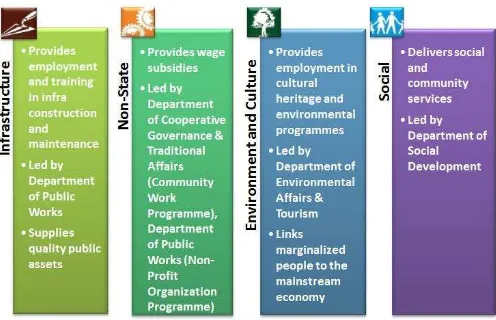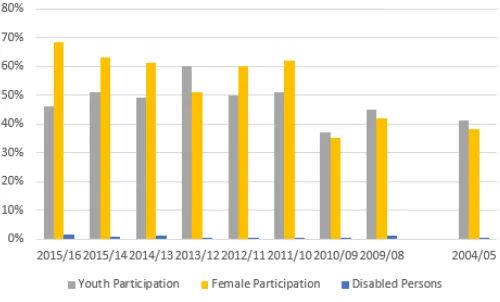ILO Social Protection Department | South Africa: Expanded Public Works Programme 1 Despite the overall economic growth in
post-apartheid South Africa, poverty and unemployment remain pressing concerns. In response to these challenges, the South African government has established the Expanded Public Works Programme to provide work and skills development opportunities for the most vulnerable.
According to STATS SA the unemployment rate stood at 25.5% in 2015, which translates to 5.3 million persons. Of these, 85% are Black Africans, a lingering legacy of apartheid policies. The youth are the worst afflicted, constituting 68% of the unemployed population. The South African National Development Plan 2030 outlines South Afri a s so ial protection strategy to protect the old and the young, as well as adults of working age who are unable to work because of structural unemployment, illness and disability. This strategy also includes supporting stronger labour market participation to tackle the current unemployment. The Expanded Public Works Programme (EPWP) was set up in 2003 to provide poverty and income relief by creating temporary work opportunities for the unskilled, unemployed, poor and vulnerable (including the disabled). Since its inception, the EPWP has generated over 8 million employment opportunities.
Main lessons learned
It is possible to provide employment-based basic income security for working age persons as
a dated y ILO s ‘e o e datio No. 202.
The establishment of the EPWP benefited from strong political support, whilst its program design process was based on social dialogue in which the National Economic Development and Labour Council (NEDLAC) was a key stakeholder.
The EPWP is delivered through existing provincial government structures to avoid duplication of institutions, as well as to increase its cost efficiency.
The EPWP has introduced new work programs to expand its job offerings beyond the infrastructure sector.
The EPWP puts emphasis on the participation of youth, women and disabled persons.
The EPWP includes a training and skills development component to enable participants to graduate into self or formal employment. This increases the EPWPs impact on increased sustainable labour market participation.
The EPWP demonstrates that public works programmes alone cannot resolve national structural unemployment. The EPWP needs to be complemented by longer-term measures such as educational reforms and economic development policies.
ILO Social Protection Department | South Africa: Expanded Public Works Programme 2 1. Poverty and unemployment in South Africa
Poverty and unemployment are endemic challenges in South Africa. Reporting from STATS SA indicates that as at 2011, 45.5% of South Africans were living below the poverty line. The incidence of poverty is highest amongst the Black Africans (54.0%), women (47.1%) and youth - aged 18 to 24 (50.7%). Education and employment remain important tools to fight poverty. Poverty rates amongst adults with no formal education was at 66.0%, whilst the rate of unemployment (as at 2014) was again highest amongst the Black Africans (28%), women (27%) and youth (16.3%). It is interesting to note that the Black Africans, women and youth represent the largest population segments of the unemployed constituting 80.2%, 51.2% and 42.7% respectively.
The Expanded Public Works Programme (EPWP) represents one of the social protection tools to address the poverty and unemployment challenges in South Africa. It has its origins in the Growth and Development Summit (GDS) of 2003. A key thematic outcome of the GDS was to deliver More jobs, better jobs, decent work for all, via public works programmes. These programmes were expected to provide poverty and income relief through temporary work for the unemployed to carry out socially useful activities.
2. How the EPWP works
The EPWP was officially launched in 2004 as a nationwide Government programme. Government and state-owned enterprises use the EPWP to generate temporary labour intensive employment opportunities through the delivery of public infrastructure (schools, roads, clinics), as well as the provision of socially useful services such as home-based care, community security and the cultivation of community gardens.
The policy design and delivery of the EPWP is the purview of the Department of Social Development (DSD), as well as the Department of Public Works (DPW). The DSD is responsible for the development of the overarching social protection policy, whilst the DPW drives the delivery, coordination and monitoring of EPWP programs. The national and provincial governments, as well as their underlying municipalities, allocate a part of their budget for the
procurement of services via the EPWP framework. The EPWP projects falls under four thematic areas (refer Figure 1), namely;
Infrastructure – creating work opportunities in construction, rehabilitation and maintenance of rural and low-volume roads, schools, clinics, etc.;
Non-state - creating work opportunities through the non-profit and community organisations to deliver communal programmes and services;
Environment and Culture - creating work opportunities in the public environment management sector (water, parks, fire, wetlands, waste etc.) as well as through cultural programmes (tourism, arts, crafts, etc.); and
Social - creating work opportunities in public social programmes including Early Childhood Development, Community Based Care, Community Safety, etc. Some of the EPWP projects also take the form of the National Youth Services Programme (NYSP). The NYSP has a mandatory training and skills development
component, as supported by the Department of Higher Education and Training.
The Minister of Labour is responsible for setting the conditions of work applicable to all EPWP participants. The stipulated conditions include defining an annually adjusted minimum wage, currently set at ZAR 88.00 (approximately USD 7.30) per day as at 1 November 2017, as well as the hours of work, overtime rates, entitlement to maternity leave, employment injury, and health and safety considerations.
Figure 1. Four thematic areas of EPWP
Source: Department of Public Works, www.epwp.gov.za
ILO Social Protection Department | South Africa: Expanded Public Works Programme 3 "entitlement to benefits prescribed by national law;"
"adequacy and predictability of benefits;" via annually adjusted minimum wage rates; and "social inclusion," with the prescribed participation targets of 55% for female and youth, and 2% for people with disabilities.
3. Impact of the EPWP
The EPWP contributes to the creation of public infrastructure, as well as the provision of social services for utilization by the wider South African population. A total of 10,469 EPWP projects were rolled out during the 2015/16 cycle. The majority of these projects were domiciled in the Infrastructure (3,839) and Social sectors (3,409), followed by the Environmental and Culture (2,619) and Non-state sectors (612).
The total number of employment opportunities created by EPWP projects totalled 741,540 in 2015/16, with an average duration of 88.25 working days (approximately four months). The total wages generated amounted to ZAR 6.1 billion (approximately USD 460 million).
The target of the EPWP Phase 1 (2004-09) was to create a cumulative total of 1 million job opportunities, a target which was attained and surpassed. The EPWP Phase 2 (2009-14) attained 80% per cent of the planned 4.5 million work opportunities in 2014. The new EPWP Phase 3 (2014-19) targets the creation of a cumulative total of 6 million work opportunities by 2019, against a Government funding commitment of ZAR 150 billion (approximately USD 11.4 billion) over five years.
Figure 2. EPWP Job Opportunities Created per Year
The EPWP has successfully included vulnerable groups such as women, youth and persons with disabilities to its pool of participants. As at 2015/16, female
participation had grown to 69%, whilst youth and the disabled comprised 46% and 2% respectively.
Figure 3. Participation by Youth, Female & Disabled Persons
The EPWP has standardized its recruitment process to ensure that participants are selected on a fair and objective basis. It has also introduced a job matching process to make sure that the profile of the selected participants complements the requirements of the employment opportunities available. The EPWP has instituted compulsory training in some of its projects, notably those targeting the youth. This is meant to
e ha e the parti ipa ts skills set and productivity, affording them the chance to graduate to self or formal employment post completion of the EPWP program. According to STATS SA 70% of past EPWP participants have since transitioned to longer term self or formal employment.
4. What’s next?
ILO Social Protection Department | South Africa: Expanded Public Works Programme 4
REFERENCES
Department of Public Works (DPW). 2009. Expanded Public Works Programme Five-Year Report 2004/05 - 2008/09 (Pretoria).
ILO Geneva 2016. World Employment & Social Outlook 2016 - Trends for Youth. Available at:
http://www.ilo.org/global/research/global-reports/youth/2016/WCMS_513739/lang--en/index.htm
Philip, K. 2013a. The Community Work Programme: Building a Society that Works. (Geneva, International Labour Organization).
South African Government. 2015. Expanded Public Works Programme. Available at: www.gov.za
Statistics South Africa (StatsSA), 2013, Census 2011 Municipality Fact Sheet. Available at: www.statssa.gov.za
Statistics South Africa (StatsSA) 2014. Poverty Trends in South Africa 2006 to 2011, 2014 (Pretoria). www.statssa.gov.za
Statistics South Africa (StatsSA) 2014. Mid-Year Population Estimates, 2014 (Pretoria). www.statssa.gov.za
Statistics South Africa (StatsSA) 2015. Labour market dynamics in South Africa, 2014 (Pretoria).
The Presidency of the Republic of South Africa. 2008-9. Accelerated and Shared Growth Initiative for South Africa (AsgiSA) 2008-9 Annual Report (Pretoria).
The Presidency of the Republic of South Africa. National Development Plan 2030 – Our Future Make it Work (Pretoria).
Building Social
Protection Floors
South Africa
–
Expanded
Public Works
February 2018
This note was produced by Kagisanyo Kelobang and Cheng Boon. It was reviewed by Loveleen De, Luis Frota and Valérie Schmitt of the ILO.
The editor of the series is Isabel Ortiz, Director of Social Protection (SOCPRO), International Labour Organization (ILO).
For more information, contact:
[email protected] and [email protected]
This work is technically supported by the Employment-Intensive Investment Programme (EIIP) of the Employment
Department (www.ilo.org/eiip). For more information regarding
the ILO s support to EPWP,
contact:
[email protected] [email protected]
Check more publications at:
www.social-protection.org
INTERNATIONAL LABOUR OFFICE
4, route des Morillons 1211 Genève 22 Switzerland
Follow us on:
www.facebook.com/SPplatform
www.linkedin.com/company/social-protection-platform www.twitter.com/soc_protection

